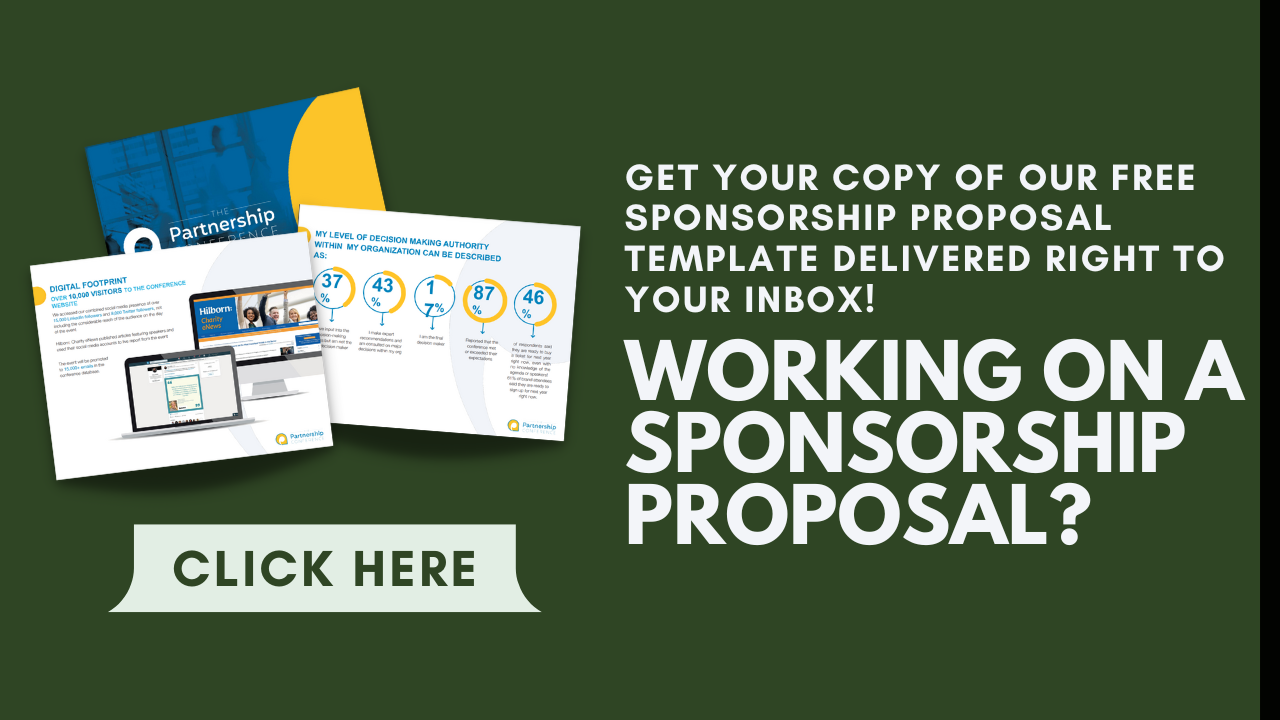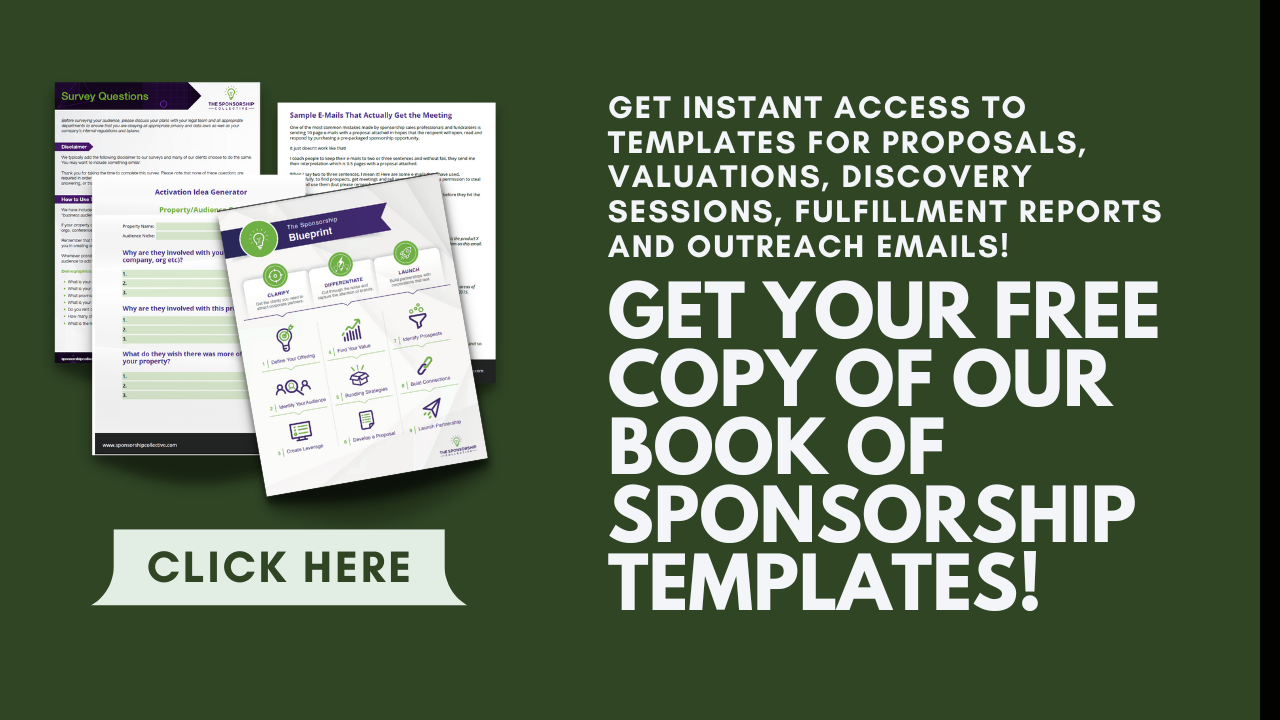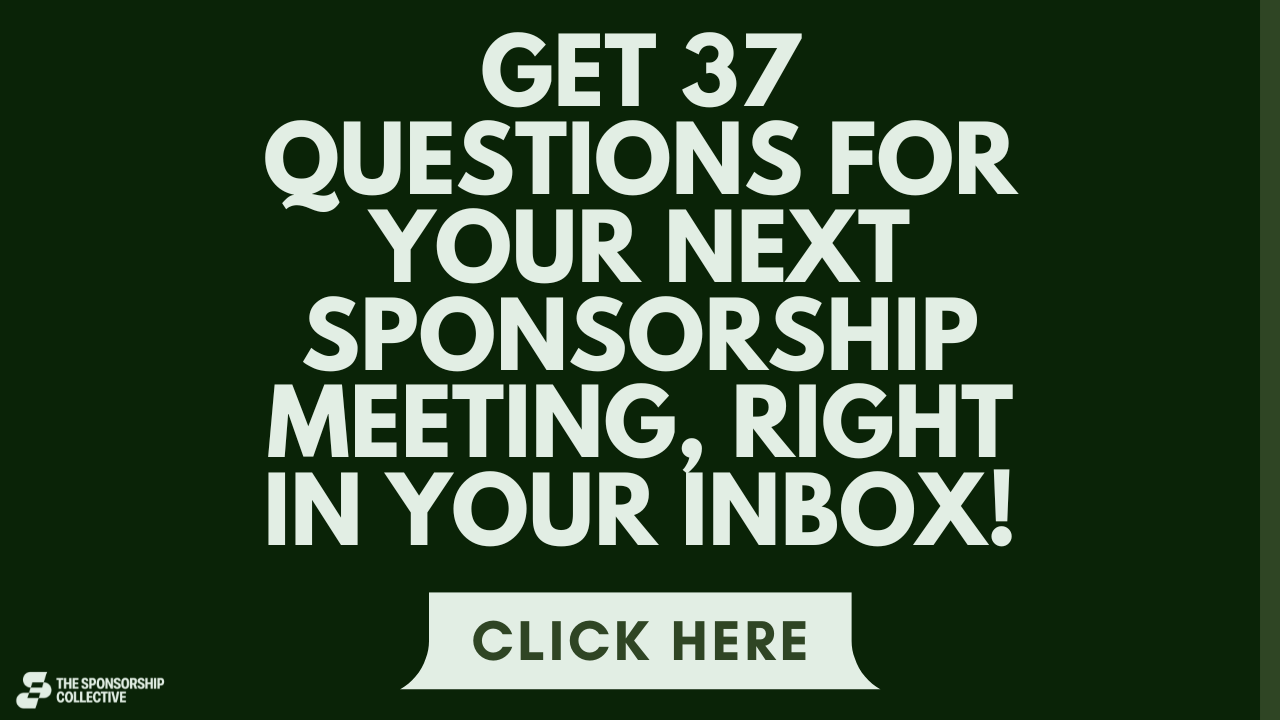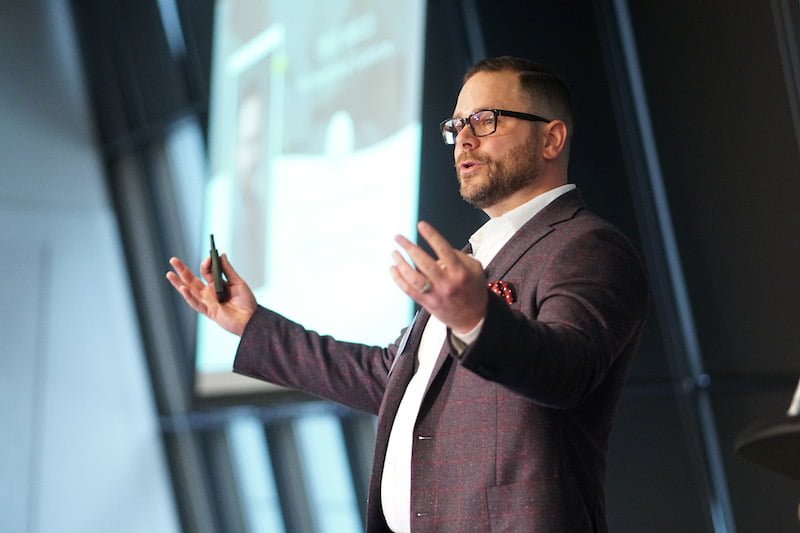When sponsorship seekers come to me, frustrated that their sponsorship program isn’t getting them the results they want, they usually assume they have to make wholesale changes. Sometimes, I recommend they do. In other instances, you only need some small tweaks to create a more effective sponsorship program. How so?
Here are 7 tiny things you can do in your sponsorship program that can make a huge difference:
- Be choosy about your prospects
- Treat your sponsors like people
- Ask your sponsor about their goals and outcomes
- Niche down audience research
- Brainstorm activations with the sponsor
- Use the discovery session for discovery questions
- Follow my template for putting together your sponsorship proposal
If you’re not quite sure what I mean about some of the points above, that’s okay. In this guide, I’ll go through the above 7 sponsorship program changes and explain why each is so important if you want to start making more sponsorship sales and build lasting professional relationships!
Try These 7 Small Changes to Your Sponsorship Program to See Big Results
Be Choosy About Your Prospects
I’ve worked with some sponsorship seekers who try to target any sponsor company they can find. My guess is they think a wider net will catch more fish.
When you’re under the gun because your event is next week and you’re still $10,000 under-funded, your better judgment can go out the window. You just want funding, and you don’t care who it comes from.
You know who will care? Your audience. From the day your company or organization was founded until now, you’ve crafted an image. You have certain values and beliefs you abide by. Throwing those by the wayside so you can get some cash or promotions for your event will turn off your audience.
I know it’s tempting to look for all companies within a 10-mile radius and cold call them or e-blast them for sponsorship, but you shouldn’t. You must be discerning about the sponsors you work with.
Your sponsor has to gel with your beliefs and values. I always use the easiest example, and I’ll do so again here. If you’re a vegan company, you don’t partner with Smash Burger.
So yes, go ahead, tighten that net a little bit. You don’t want to catch all the fish anyway. That’s not the point. You want to catch a certain type of fish.
Speaking non-metaphorically, when you begin to search for target sponsors, don’t just look up a name and then add them to your e-blast list. Put some time in. Get to know the basics about the company, including what they do, what they sell, and who buys it.
You shouldn’t have to pour hours of your day into this. A solid 30-minute research session should suffice. Start on the company’s website, then look through their social media feeds. Comb through their LinkedIn page as well.
If you notice any red flags, such as value mismatches, then discard the sponsor early. For the sponsors you decide to pursue going forward, keep in mind that many will be disqualified along the way, either by your own criteria or by them deciding not to work with you.
Treat Your Sponsors Like People
Here’s a mistake that’s very common among first-time sponsorship seekers that can really derail your sponsorship program.
Sponsorship seekers, being new to this, aren’t quite sure how to treat the representatives at the sponsor company. Since the sponsorship seeker is receiving money in exchange for assets, the relationship can take on a very transactional feel.
In other words, it’s a straightforward relationship with very little warmth.
That approach is fine if you don’t care about working with the same sponsors again. If you’re chasing after repeat arrangements though, there’s a lot to be said about kindness and consideration.
The reps at the sponsor company are people. They’re married or single, they have pets or children, and hobbies and interests outside of work. They’re multidimensional like you.
Bearing that in mind anytime you interact with the sponsor can make a huge difference. You might find it less awkward to speak to the sponsor on the phone. It will be easier to break the ice when you two first meet.
You’ll feel more comfortable with the sponsor, so sharing ideas will be a lot easier. This can help your sponsorship arrangement flourish.
Best of all, when the time comes to discuss sponsorship renewal, the sponsor might be more interested.
Now, I do want to be clear. You can be the sponsor’s best friend, but if you underdeliver on your goals, then no amount of camaraderie can make up for that.
Oh, and speaking of being best friends with the sponsor, that’s something else you have to watch out for. I talk more about that in this post. Sometimes, when you get too buddy-buddy with a sponsor, you can start talking more about personal matters and forget all about your sponsorship program.
Striking up a friendship is fine and dandy, but you must put business first. I always recommend not necessarily being a sponsor’s friend, but a champion and advocate for them. That goes a long way.
Ask Your Sponsor about Their Goals and Outcomes
In a recent post of mine, I talked about sponsorship selling from the frontlines. If you missed that post, you should check it out, but I’ll recap it here.
Like you, I used to be a sponsorship seeker for a company. I had a boss who didn’t know anything about sponsorship, so I was tasked with calling up sponsors and trying to making the sponsorship sale.
After enough rejections, I decided to change my approach. I discussed the sponsor’s goals with them directly, then put together a package I could sell to my boss. The result? I broke sponsorship sales records with that company.
The straightforward and direct approach, while not always easy, usually pays off. When I asked my sponsors what kind of outcomes they were trying to achieve, I got great information. Then I was able to ask them which outcomes they needed to have versus those they wanted to have.
From there, it was just a matter of packaging assets.
Between your research, discovery session (more on this to come), and subsequent meetings with the sponsor, you might still be missing a few key pieces of information on their goals and/or desired outcomes.
Be upfront and ask for what you need. Don’t assume you know what the sponsor wants. Don’t guess based on their past decisions. And please don’t let your own judgments influence what you think the sponsor would do.
Just ask!
Niche Down Audience Research
I’m assuming that at this point in your sponsorship program, you’ve taken the time to do your audience survey. If you haven’t, this guide is full of best practices that will tell you how to issue an audience survey, when, for how long, and how to tabulate the results.
You probably broke up your audience into segments using basic demographics, geographics, and psychographics, right? That’s a good start, but why stop there?
I mention a famous marketing quote often on the blog that goes like this: the riches are in the niches.
This means that the more niched down your audience is, the more valuable those audience segments become.
Here’s what you should do. For each audience segment you currently have, determine how you can niche it down further. For example, let’s say one of your segments is 20-to-25-year-old men from Pittsburgh.
You could obviously niche down by age between 20 and 25 years old. You can also segment by neighborhoods in Pittsburgh, of which there are 90 different ones. Maybe you look at the occupations of your audience members, their income, how long they’ve been your customer, or how much money they’ve spent with you.
When niching down your audience, the goal isn’t to do so randomly. You’re trying to create audience segments that are as appealing to your sponsor as possible. If your sponsor is based in Pittsburgh, then is it worth segmenting your audience by Pittsburgh neighborhoods? Yes.
For a sponsor outside of Pittsburgh though, that kind of niching down is less valuable. You’re just spending hours upon hours doing busywork, and I’m trying to save you time in your sponsorship program here.
Brainstorm Activations with the Sponsor
I just published a post about the first thing you should do after penning a sponsorship deal. If you had to guess, what do you think it is?
I’ll tell you, because it’s a rather unexpected move. You’re supposed to start talking about activation ideas.
Yes, that means you should hold off on the invoice for now as well as the celebratory bottle of champagne.
Although it might seem late in the game to talk about activation opportunities, I deem the post-contract singing the best time to do it. With negotiations already taken care of, you have a lot more brainpower to put into your ideas.
You’re also pretty comfortable with the sponsor by now, maybe even buddy-buddy. As I talked about earlier, this level of comfort can make it easier for you to bring up ideas that you might have otherwise kept to yourself.
Activation opportunities are part of your special sauce, which is what makes you stand out to sponsorship prospects. To come up with activations that excite your sponsor, you need to have a very clear understanding of their goals.
That’s why I recommended earlier that you discuss sponsorship outcomes with the sponsor. This is where that information really comes in handy.
Besides the needs of your sponsor, you must also know what your audience needs. Your base audience research provided some of the pieces of that puzzle but niching down will give you the rest.
When you can find a way to connect the audience to the sponsor while solving the respective needs of both groups, that’s when the stars align, and you’ve got amazing activations.
It’s not always easy to think of such great activation ideas yourself, and that’s okay! Brainstorm among your own team and then work closely with the sponsor to begin narrowing down the best ideas.
Use the Discovery Session for Discovery Questions
The discovery session is one of the most integral pieces of your sponsorship program, yet many first-time sponsorship seekers squander what is a golden opportunity. This is rarely done on purpose, mostly through inexperience.
The discovery session is not a time for sales materials. If you’ve put together your sponsorship proposal already (keep reading for more on this), now is not the time to brandish it and excitedly show it to the sponsor. They don’t want to see it.
The discovery session is for asking questions that will eventually result in a sponsorship sale. You’re learning all about the sponsor as you go, including their goals, their target audience, that audience’s buying behavior, and which ROIs matter to the sponsor.
To get you started, I have more than 30 discovery questions you can browse and read through. You have to choose your discovery questions wisely, as you can only ask between five and seven during the meeting. Bombarding the sponsor with questions feels too much like an interrogation.
The goal of asking these questions is to determine whether you can help the sponsor achieve their goals. This is gut-check time for you, and a moment where you have to be frankly honest. If the sponsor’s goals just don’t align with what you can offer, then you have to circle back around and start with the next sponsor on your list.
Follow My Template for Putting Together Your Sponsorship Proposal
I said I’d talk about sponsorship proposals, and that’s what I want to do now.
The sponsorship proposal is a very important document, as it pulls together all the most pertinent details of the sponsorship arrangement. Your assets menu is in there, information about your company or organization is in there, and details about your event or opportunity go in there as well.
Getting your sponsorship proposal right the first time will greatly benefit your sponsorship program. Fortunately, I have a sponsorship proposal template that goes through all six pages–including paragraph by paragraph for some pages–explaining everything you need to know.
Even if you have a five-star proposal (which you will after following the template), you still have to use this document wisely. As I said, don’t bring it to the discovery session or any subsequent meetings. Leave it in the office until the sponsor asks to see it.
Conclusion
If your sponsorship program feels hopeless right now, it could be that you’re making a few small mistakes. The 7 changes I recommended in this article are a great starting point. You should also check out my free training called How to Grow Your Sponsorship Program!
- About the Author
- Latest Posts
Chris Baylis is the Founder and Editor-in-Chief of The Sponsorship Collective.
After spending several years in the field as a sponsorship professional and consultant, Chris now spends his time working with clients to help them understand their audiences, build activations that sponsors want, apply market values to their assets and build strategies that drive sales.
Read More about Chris Baylis




